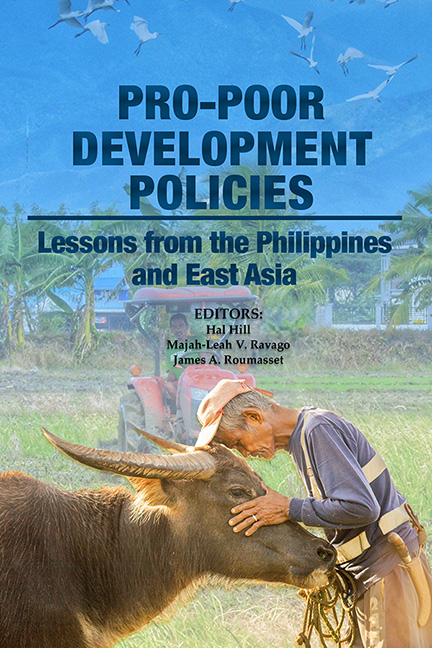Book contents
- Frontmatter
- Dedication
- Contents
- Figures, Tables and Boxes
- Foreword
- Foreword
- Message
- Preface and Acknowledgements
- About the Editors
- About the Contributors
- Acronyms
- Part 1 Introduction and Synthesis
- Part 2 Agricultural and Economic Development
- Part 3 Economic Policies for Achieving Targeted Levels of Living in the Philippines
- Part 4 Inequality and Economic Development
- Part 5 Competition Law and Policy
- Part 6 International Dimensions
- Index
5 - The Role of Agricultural and Structural Transformations in Rural Poverty Reduction
Published online by Cambridge University Press: 09 January 2024
- Frontmatter
- Dedication
- Contents
- Figures, Tables and Boxes
- Foreword
- Foreword
- Message
- Preface and Acknowledgements
- About the Editors
- About the Contributors
- Acronyms
- Part 1 Introduction and Synthesis
- Part 2 Agricultural and Economic Development
- Part 3 Economic Policies for Achieving Targeted Levels of Living in the Philippines
- Part 4 Inequality and Economic Development
- Part 5 Competition Law and Policy
- Part 6 International Dimensions
- Index
Summary
INTRODUCTION
It is my great honour to participate in this Festschrift to recognize the contribution of Professor Arsenio M. Balisacan in development economics, especially in agricultural and rural development. I took his course on macroeconomics at the University of the Philippines Los Baños in the late 1980s; we have closely kept in touch through various academic activities and conferences since the early 1990s. Professor Balisacan has contributed significantly to our understanding of rural development and poverty reduction in Asia, in general, and the Philippines, in particular. Because of this, I decided to write this paper on facilitating a more inclusive agricultural transformation, focusing on China, the Philippines and three other Southeast Asian countries for which I have data.
China and Southeast Asia are interesting cases because they have experienced rapid economic growth. Average annual growth of gross domestic product (GDP) in China and Southeast Asia recorded 9.5 per cent and 5.0 per cent, respectively, in 1990–2019, which were much higher than the 3.3 per cent global GDP annual growth rate over the same period. China and Southeast Asia have also experienced rapid urbanization. The share of urban population increased from 19 per cent in 1980 to 61 per cent in 2019 in China; it was from 26 per cent to nearly 50 per cent in Southeast Asia for the same period.
The rising income and urbanization have resulted in significant changes in the food demand and rural transformation in China and Southeast Asia. In general, as income increased and urban areas expanded, so has consumer demand for more food and diversified diets (Reardon and Timmer 2014). In responding to the food demand changes, agricultural production has also been gradually shifting from cereal to non-cereal commodities, including high-value crops, livestock and fishery. Urbanization and structural transformation have been accompanied also by rapid growth of off-farm employment in China and many countries in Asia (Haggblade, Hazell, and Reardon 2010; Hoang, Cong, and Ulubasoglu 2014; Huang and Shi 2021).
In Asia, rural transformation within agriculture is often associated with the fall in rural poverty (IFAD 2016).
- Type
- Chapter
- Information
- Pro-poor Development PoliciesLessons from the Philippines and East Asia, pp. 116 - 132Publisher: ISEAS–Yusof Ishak InstitutePrint publication year: 2022



